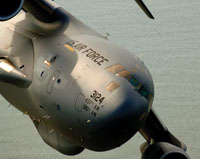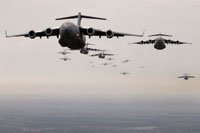CHARLESTON AFB
The closest military installation to the Naval Weapons Station is Charleston Air Force Base which shares a joint-use airfield with Charleston International Airport. The Air Force Base is home to the 437th Airlift Wing and its Reserve associate unit, the 315th Airlift Wing. Together, they fly C-17 Globemaster III aircraft, the newest, most flexible cargo aircraft to enter the airlift force.
The mission of the two Wings is to airlift troops and passengers, military equipment and cargo, and medical patients where ever required. The aircraft can carry approximately 85 tons of cargo or equipment--the equivalent of two large buses, three helicopters, one of the Army’s newest tanks or other outsized cargo. In addition, the C-17 can land on airfields as short as 3,000 feet, or airdrop up to 102 paratroopers and cargo.
In recent years, it has used many of these capabilities in support of military operations in Afghanistan and Iraq. In addition, the 437th Airlift Wing flew 40 humanitarian missions in support of Hurricane Katrina, airlifting 1,736 patients/evacuees, 1,217 passengers/relief workers, and 1,541 tons of cargo to and from locations such as New Orleans and Keesler AFB, Miss.
With more than 7,500 active duty, reserve, and civilian employees, Charleston Air Force Base is the third largest employer in the Charleston area, contributing approximately $790 million annually to the local economy.
Established as an airfield and flying service at Charleston’s airport in 1931, the Army Air Corps took control of the airfield in 1941 to establish air defenses for the eastern coast of the U.S. during World War II. The first military flights from the field were anti-submarine missions.
Military operations at the airfield ended after the war until 1949 when the 437th Airlift Wing was reactivated as a reserve unit. Three years later, Charleston and the Air Force agreed to establish a Troop Carrier base, with joint use of the runway. The base has supported military airlift operations ever since. In 1993, the Charleston Wing became the first unit in the United States to receive operational C-17 aircraft, which expanded America’s global reach airlift capability.
Joint services can be expected to expand in future years as a result of the 2005 BRAC commission decision to link Naval Weapons Station Charleston and Charleston Air Force Base though a “Joint Basing Program” scheduled to be implemented no later than September of 2011. Under this program, partnerships will abound between the two bases which are designed to reduce redundancies, increase efficiencies, maximize cost effectiveness and – most importantly – improve services to you, our most valued customer.
The Naval Weapons Station Charleston Newcomers' Guide is published by Benchmark Publications Incorporated, a private firm in no way connected with the Department of the Navy, under exclusive written contract with Naval Weapons Station Charleston. The appearance of advertising in this publication, including inserts and supplements, does not constitute endorsement by the Department of the Navy or Benchmark Publications, Incorporated of the products or services advertised. Everything advertised in this publication shall be made available for purchase, use or patronage without regard to race, color, religion, sex, national origin, age, marital status, physical handicap, political affiliation or any other non-merit factor of the purchaser, user or patron. If a violation or rejection of this equal opportunity policy by an advertiser is confirmed, the publisher shall refuse to print advertising from that source until the violation is corrected. The Naval Weapons Station Charleston Newcomers' Guide is an unofficial publication authorized by AR 360-81. Editorial content is prepared, edited and provided by the Public Affairs Office of the Naval Weapons Station Charleston. All photos are provided by the Public Affairs Office unless stated otherwise.



